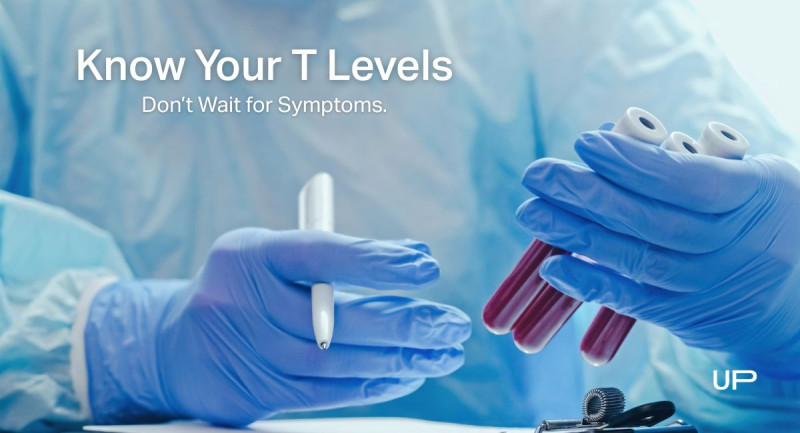Why It’s Smart To Get A Testosterone Blood Test Early (Even If You Feel Fine)


It is easy to assume that if you feel fine you have nothing to worry about, but when it comes to hormones like testosterone, that assumption may leave you unprepared.

In Canada, men often wait until they feel fatigued, lose muscle, or struggle with mood before checking their hormones. Yet a simple testosterone blood test can establish a baseline before symptoms creep in and give you and your doctor valuable insight into your health.
If you ever need testosterone replacement therapy (TRT) in Canada, having that baseline ensures your treatment is based on data rather than guesswork.
Topics covered in this article:
Key Takeaways (1-Minute Summary)
- Getting a testosterone blood test early gives you a personal baseline before symptoms of low testosterone appear.
- Everyone’s “normal” is different. Baseline testing helps you track meaningful changes over time.
- Low testosterone can affect energy, mood, sleep, and muscle tone long before you notice major symptoms.
- In Canada, testosterone testing is simple and accessible through family doctors, telehealth, or private labs.
- If your levels ever drop, your baseline helps guide safe and effective treatment, including testosterone replacement therapy (TRT) in Canada.

What Testosterone Does for Men’s Health
Testosterone is more than just the “male hormone.” It’s the fuel behind many of the body’s most important systems — from energy and mood to muscle strength and focus. Even a small drop in testosterone levels can have a ripple effect on how you feel and function day to day.
For men in Canada, testosterone testing provides a clear window into overall health because the hormone influences so many areas of the body, including:
- Energy and Motivation: Testosterone helps your cells produce energy efficiently. When levels dip, fatigue, irritability, or mental fog can appear.
- Muscle and Strength: It supports muscle growth and recovery. Lower testosterone often makes it harder to build or maintain lean mass, even with regular exercise.
- Mood and Focus: Balanced testosterone levels help regulate serotonin and dopamine, the “feel-good” chemicals that influence motivation and concentration.
- Libido and Sexual Function: Healthy testosterone supports desire, arousal, and performance. Drops in levels can affect sexual confidence and relationship satisfaction.
- Sleep and Recovery: Testosterone peaks during deep sleep, helping the body recover from stress and physical effort. Poor sleep can reduce hormone production even further.
After age 30, testosterone naturally declines by about 1% per year. That may not sound like much, but over a decade or two, it can add up — especially if lifestyle factors like stress, poor diet, or lack of sleep accelerate the drop. This is why regular testing helps men stay ahead of the curve, even before symptoms show up.
The Power of a Baseline
Getting a testosterone blood test while you still feel healthy might seem unnecessary, but it’s actually one of the smartest things you can do for your long-term health. Think of it as getting to know your body’s “default settings.” Once you understand what’s normal for you, it becomes much easier to notice changes before they become problems.

Here’s why establishing a baseline matters:
- Your “normal” might not match the lab average. Most lab reference ranges are based on population data, not individual health. You could fall within the “normal” range but still feel symptoms if your personal baseline is higher than average.
- Early tracking prevents surprises later. Subtle dips in testosterone can affect mood, sleep, and energy before you realize it. Knowing your baseline lets you compare future results and take early action.
- Helps your doctor make smarter decisions. Whether it’s lifestyle adjustments or, later on, testosterone replacement therapy (TRT) in Canada, having that data ensures your treatment is tailored to your real needs.
- Supports long-term wellness. Tracking your levels over time gives you a fuller picture of how stress, diet, or age affect your hormones—and lets you stay in control of your health.
Understanding your baseline isn’t about being alarmed; it’s about being informed. It gives you the confidence to make proactive choices rather than reactive ones.
When and How to Get Tested in Canada
Testing your testosterone levels is simple, quick, and doesn’t require any major preparation. In Canada, you can request a testosterone blood test through your family doctor, a telehealth provider, or even a licensed online clinic that can send you a lab requisition form. The goal is to measure your hormone levels accurately so that you and your healthcare provider can make informed decisions about your long-term health.
Best Time to Test
- Testosterone levels naturally rise and fall throughout the day.
- The best time to test is in the morning between 7 and 10 a.m., when levels are typically at their highest.
- If your results are borderline or inconsistent, your provider may recommend a repeat test to confirm accuracy.
What’s Measured
A complete testosterone panel usually includes:
- Total Testosterone: The overall amount of testosterone circulating in your blood.
- Free Testosterone: The portion of testosterone that is not bound to proteins and is available for use by the body.
- SHBG (Sex Hormone-Binding Globulin): A protein that binds to testosterone; high SHBG can reduce the amount of free testosterone.
- Estradiol (Estrogen): Often checked alongside testosterone to ensure hormonal balance.
Testing Options in Canada
- Family Doctor or Specialist: Covered under most provincial health plans if medically necessary.
- Private Labs: Offer faster results, usually for $50–$100 if paid out of pocket.
- Telehealth and Online Clinics: Convenient and popular options that connect you with licensed Canadian providers who can order the tests for you remotely.
Understanding Provincial Coverage
In Canada, most provinces cover testosterone testing when there’s a medical reason — such as fatigue, low libido, or other related symptoms. If you’re testing preventively to establish a baseline, some private labs or telehealth providers can still arrange it at a modest cost.
Understanding Your Results
Once your testosterone test results come in, it’s important to know what those numbers actually mean. Lab reports can look intimidating, but with a little context, you can understand where you stand and what might come next.
Normal Testosterone Ranges
For adult men, total testosterone levels are generally considered normal between 8 to 30 nmol/L (nanomoles per litre). However, this range is quite broad — what feels normal for one man may not feel right for another. It’s also important to note that testosterone reference ranges can vary slightly between labs in Canada, depending on testing methods and calibration standards. That’s why your healthcare provider is the best person to interpret your numbers and explain what’s optimal for you.
- Above 15 nmol/L: Typically considered healthy for most men.
- 10–14 nmol/L: May still be within the “normal” range, but some men start to notice low-T symptoms here.
- Below 8 nmol/L: Usually considered low and may warrant further testing or evaluation for testosterone replacement therapy (TRT) in Canada.

Why Context Matters
Your testosterone results should always be interpreted by a healthcare professional. Several factors can temporarily affect your readings, such as stress, illness, poor sleep, or even the time of day. That’s why doctors often look at more than one test result before making any decisions.
Having your baseline testosterone level gives your provider valuable context. If your levels drop over time — even within the normal range — it could signal that your body is changing and needs attention.
Other Important Markers
If your lab report includes free testosterone and SHBG, these help paint a fuller picture. For instance:
- High SHBG can make total testosterone look normal even when free testosterone (the usable form) is low.
- Free testosterone reflects how much of the hormone is actually available for your body to use.
The Takeaway
Don’t panic if your results aren’t perfect. One test alone doesn’t define your health. The key is to monitor trends, discuss results with a qualified provider, and focus on how you feel — not just the numbers.
What to Do If Levels Are Low or Fluctuating
If your testosterone levels come back on the lower side, don’t panic — it doesn’t automatically mean something is wrong. Hormone levels can fluctuate naturally throughout the day, and even from one week to the next. The first step is to confirm your results and identify whether the issue is temporary or part of a longer trend.
Step 1: Retest and Review With a Healthcare Provider
Your doctor may suggest repeating the test, especially if your first results were borderline. They’ll likely check your free testosterone, SHBG, and related hormones to see the full picture. It’s also a good idea to discuss your symptoms — such as fatigue, mood changes, or low libido — since numbers alone don’t always tell the full story.
Step 2: Make Lifestyle Adjustments
Before moving toward any medical treatment, simple daily changes can have a real impact on testosterone balance. Focus on:
- Getting enough sleep: Aim for seven to eight hours per night. Testosterone is produced during deep sleep.
- Regular exercise: Strength training and resistance workouts can help raise natural testosterone levels.
- Nutrition: Include protein, zinc, magnesium, and healthy fats from foods like fish, eggs, and nuts.
- Stress management: Chronic stress increases cortisol, which can suppress testosterone.
- Maintaining a healthy weight: Excess body fat, especially around the abdomen, is linked to lower testosterone.
Step 3: Explore Medical Options if Needed
If lifestyle changes aren’t enough and your levels remain low, your provider might discuss medical treatments such as testosterone replacement therapy (TRT). In Canada, TRT is available in several forms — injections, gels, or patches — and must always be prescribed by a licensed healthcare professional. The goal isn’t just to raise testosterone, but to restore it to the range that’s right for you, based on your symptoms and baseline data.
The Takeaway
Low or fluctuating testosterone doesn’t always mean you need treatment right away. Sometimes, small lifestyle tweaks are enough to bring levels back to normal. What matters most is working with a healthcare provider who understands men’s hormone health and can guide you safely through testing, monitoring, and treatment if needed.

Conclusion
Getting a testosterone blood test isn’t just for men who already feel tired, moody, or unmotivated. It’s for any man who wants to take a proactive, informed approach to his long-term health. By testing early and knowing your baseline testosterone level, you create a roadmap that helps you and your healthcare provider track changes over time and take action before low testosterone begins to affect your quality of life.
In Canada, testing is simple, accessible, and supported by experienced providers who can interpret your results and guide next steps. Whether you choose to get tested through your family doctor, a telehealth service, or a private lab, having those numbers in hand gives you clarity and control.
Think of testosterone testing as one part of your overall health strategy — just like regular checkups or monitoring blood pressure. The earlier you start, the better equipped you’ll be to protect your energy, confidence, and vitality for years to come.
Frequently Asked Questions
If you’re a man over 30 and want to take charge of your long-term health, getting a testosterone test is a smart move — even if you feel fine. It helps you establish a baseline so you can detect changes early. You should also consider testing if you notice fatigue, low mood, decreased motivation, reduced muscle strength, or changes in sexual health.
The best time to get tested is in the morning between 7 a.m. and 10 a.m., when testosterone levels are naturally at their highest. If your results are borderline, your doctor may ask you to repeat the test on another morning for accuracy.
Total testosterone measures all the testosterone in your blood, while free testosterone measures only the amount that’s not bound to proteins and is available for your body to use. Both numbers matter, and your healthcare provider can explain how they work together.
Yes, and they often make a big difference. Regular exercise, good sleep, balanced nutrition, and weight management can all help support healthy testosterone production. Avoiding excessive stress, alcohol, and smoking also helps keep hormone levels stable.
Not necessarily. Low levels on a single test don’t always mean you need treatment. Your provider may repeat the test, check related hormones, and review your symptoms before deciding. If TRT is recommended, it will be based on medical need and monitored carefully for safety, as is standard practice in Canada.
Yes. Many licensed telehealth platforms and online clinics in Canada offer lab requisitions for testosterone testing. You’ll receive a form, visit a local partner lab, and get results reviewed by a healthcare professional — often without needing an in-person appointment.
References
UPGUYS has strict sourcing guidelines to ensure our content is accurate and current. We rely on peer-reviewed studies, academic research institutions, and medical associations. We strive to use primary sources and refrain from using tertiary references.- Cardiovascular Safety of Testosterone-Replacement Therapy, The New England Journal of Medicine,
https://www.nejm.org/doi/full/10.1056/NEJMoa2215025 - Male menopause: Myth or reality?, Mayo Clinic,
https://www.mayoclinic.org/healthy-lifestyle/mens-health/in-depth/male-menopause/art-20048056 - Why Are Testosterone Levels Decreasing? Cleveland Clinic,
https://health.clevelandclinic.org/declining-testosterone-levels
This article is written for informational purposes only and does not constitute medical advice. The information provided in the articles cannot and should not replace advice from a healthcare professional. Talk to your healthcare provider about any physical or mental health concerns or the risks and benefits of any treatment or medication.





